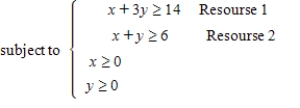You are given a linear programming problem. Use the method of corners to solve the problem.
Minimize 

 = __________
= __________  = __________
= __________  = __________
= __________
Find the range of values that the coefficient of  can assume without changing the optimal solution.
can assume without changing the optimal solution.
≤ c ≤
Find the range of values that requirement 1 can assume.
≤ b ≤
Find the shadow price for requirement 1. Enter your answer to two decimal places, if necessary.
$ __________
Identify the binding and nonbinding constraints.
Constraint 1 is __________
Constraint 2 is __________
Definitions:
DuPont Formula
An expanded expression of return on investment (ROI) determined by multiplying the profit margin by the investment turnover.
Return on Investment
Return on Investment, or ROI, measures the gain or loss generated on an investment relative to the amount of money invested.
Invested Assets
Financial assets purchased with the expectation that they will generate income or profit, or appreciate in value.
Operating Income
Earnings before interest and taxes (EBIT) is a company's profit from normal operations, excluding non-operating income and expenses.
Q22: Consider the linear programming problem. <img src="https://d2lvgg3v3hfg70.cloudfront.net/TB6027/.jpg"
Q24: Georgia purchased a house in 1997 for
Q28: A hunger-relief organization, has earmarked between $2
Q31: Write a system of linear inequalities that
Q33: Kane Manufacturing has a division that produces
Q118: Find the optimal (maximum and/or minimum) value(s)
Q125: Minimizing Shipping Costs. Towns A, B, C,
Q164: Indicate whether the matrix is in row-reduced
Q165: Jackson Farms have allotted a certain amount
Q255: Cindy regularly makes long distance phone calls